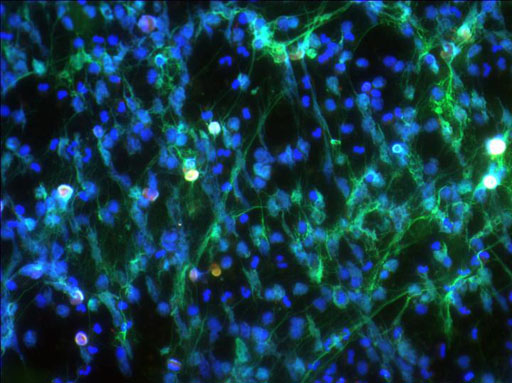Bacterial Motility Is Required to Trigger Neutrophil Immune Response
By Gerald M. Slutzky, PhD
Posted on 13 Dec 2016
A team of molecular microbiologists has found that the flagellar motion, which propels Pseudomonas aeruginosa bacteria, was required to generate an immune response, especially the production of neutrophil extracellular traps (NETs).Posted on 13 Dec 2016
NETs are molecular lattices of decondensed chromatin embedded with histones, granule enzymes, and antimicrobial peptides that are extruded by immune system neutrophil granulocytes, (polymorphonuclear leukocytes or PMNs) to capture and contain bacteria, viruses, and other pathogens. Experimental evidence has indicated that NETs also cause inflammatory vascular and tissue damage, suggesting that identifying pathways that inhibit NET formation may have therapeutic implications.

Image: A photomicrograph of NETs following four hours of immunofluorescence staining (Photo courtesy of Madison Floyd, Rada Laboratory, University of Georgia).
Although NET formation is an important antimicrobial process, the details of its mechanism are largely unknown, and the identity of the main components of P. aeruginosa responsible for triggering NET formation is unclear. For these reasons investigators at the University of Georgia (Athens, USA) sought to identify the main bacterial factors mediating NET formation and to gain insight into the underlying mechanism.
The investigators reported in the November 17, 2016, online edition of the journal PLOS Pathogens that P. aeruginosa in its exponential growth phase promoted strong NET formation in human neutrophils while its NET-inducing ability dramatically decreased at later stages of bacterial growth. They identified the flagellum as the primary component of P. aeruginosa responsible for inducing NET extrusion, since flagellum-deficient bacteria remained seriously impaired in triggering NET formation. Purified P. aeruginosa flagellin, the monomeric component of the flagellum, did not stimulate NET formation in human neutrophils.
Flagellar motility, not flagellum binding to neutrophils mediated NET release induced by flagellated bacteria. Immotile, flagellar motor-deficient bacterial strains producing paralyzed flagella did not induce NET formation. However, forced contact between immotile P. aeruginosa and neutrophils restored their NET-inducing ability.
"This previously uncharted territory suggests not only the importance of bacterial motility but also that neutrophils are a key cell type to study with regards to P. aeruginosa infections," said senior author Dr. Balázs Rada, assistant professor of infectious diseases at the University of Georgia. "It is the most powerful branch of the immune system to fight P. aeruginosa, and our study shows how the bacteria and neutrophils interact. It is a step along the way to direct research attention toward bacterial motility. It is an important feature of the bacterium that has been neglected in the past."
Related Links:
University of Georgia













